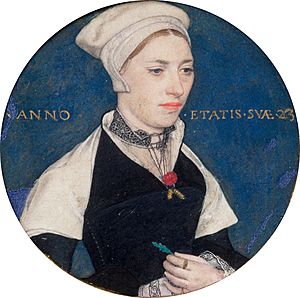Jane Pemberton Small facts for kids
Jane Small lived a long time ago, from about 1518 to 1602. She was the daughter of Christopher Pemberton, a gentleman from Northamptonshire, England. Jane is famous because she was the subject of a tiny, detailed painting called a portrait miniature. This painting was made by a very well-known German artist named Hans Holbein the Younger around the year 1540. Holbein was a special painter for the English royal family. He even painted King Henry VIII and some of his wives!
Jane Small's Life Story
Jane Pemberton married Nicholas Small, who was a cloth merchant in London. They likely got married around 1540. This was also when the famous painting of Jane was asked for. Nicholas Small passed away in the winter of 1565 or 1566.
Within a year, Jane married again to Nicholas Parkinson. Her second husband later became the head of the Clothworkers' Company in 1578 or 1579. Nicholas Parkinson died in the winter of 1581 or 1582.
At that time, Jane lived in Paddington, in a large house called a rectory. This house was big enough that it was rented out to important people. Jane also owned a lease on a property called 'The Hand' on Thames Street in London. This street runs along the River Thames.
Later in her life, Jane lived with her daughters. She preferred to be called Jane Small. She died in May 1602 while visiting her granddaughter in Warwickshire. We do not know where she was buried.
Jane Small's Family
Jane Small and Nicholas Small had six children together. After her second husband died without a will, her oldest son, Matthew Small, inherited his property. This happened after a court hearing.
One of Jane's younger daughters, Elizabeth, married Jasper More. He was from Shropshire. Jane's granddaughter, Katherine More, was involved in a very unusual event. This happened between her and her husband, Samuel More, from about 1616 to 1620.
Many court cases took place. In 1620, Samuel More placed their four children with the Pilgrims. This happened just before the ship, the Mayflower, sailed for America. Soon after the Mayflower arrived in America, three of the four children died. Only Katherine's son, Richard More, survived.
The Famous Holbein Portrait
Jane Small is important in history because of the beautiful portrait miniature painted by Hans Holbein the Younger. We know it's her because of a special drawing on the back of the painting. This drawing shows the coat of arms (a family symbol) of Robert Pemberton. He was from Lancashire and Rushden, Northamptonshire.
The coat of arms is dated 1566, but it was actually painted in the 1600s. At first, experts thought the person in the painting was Margaret Throckmorton. She was Robert Pemberton's wife and had connections to the royal court. But more recently, it has been confirmed that Jane Small is the person in the portrait.
The simple clothes Jane wears in the painting show that she was not from the royal court. Most English women Holbein painted were part of the court. The painting says that Jane was 23 years old when it was made. However, we don't know the exact date the painting was finished.
Some people think the portrait was made to celebrate her engagement. She is shown wearing a carnation flower, which might mean she was engaged to be married. She is also holding a leaf or a small branch. Holbein's painting has a rich blue background and clear lines. It is considered a masterpiece of miniature painting.
In his later years, Holbein made the art of the portrait miniature very popular and brilliant. His larger paintings always had tiny, precise details. He used this skill for smaller paintings. He still managed to make them feel grand and important. His miniature portrait of Jane Small is seen as one of the best examples of this type of art.
See also
- List of paintings by Hans Holbein the Younger
- Katherine More, Jane Small's granddaughter


